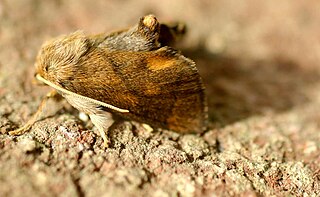
The flannel moths or crinkled flannel moths are a family of insects. They occur in North America and the New World tropics.

The Drepanidae are a family of moths with about 660 species described worldwide. They are generally divided in three subfamilies, which share the same type of hearing organ. Thyatirinae, previously often placed in their own family, bear a superficial resemblance to Noctuidae. Many species in the drepanid family have a distinctively hook-shaped apex to the fore wing, leading to their common name of hook-tips.

The Pyraloidea are a moth superfamily containing about 16,000 described species worldwide, and probably at least as many more remain to be described. They are generally fairly small moths, and as such, they have been traditionally associated with the paraphyletic Microlepidoptera.

The Limacodidae or Eucleidae are a family of moths in the superfamily Zygaenoidea or the Cossoidea; the placement is in dispute. They are often called slug moths because their caterpillars bear a distinct resemblance to slugs. They are also called cup moths because of the shape of their cocoons.

Callidulidae, the only known family of the superfamily Calliduloidea, is the family of Old World butterfly-moths, containing eight genera. They have a peculiar distribution, restricted to the Old World tropics of Southeast Asia to Australasia and Madagascar. The three subfamilies exhibit both day- and night-flying behaviour.
Awilda "Wiwi" Carbia was a Puerto Rican actress, comedian, and impersonator.
Carbia is a genus of moths in the family Geometridae.

Herochroma baibarana is a species of moth of the family Geometridae first described by Shōnen Matsumura in 1931. It is found in China, Taiwan, Sri Lanka, the north-eastern parts of the Himalayas, Peninsular Malaysia, Sumatra and Borneo.

Asthenini is a tribe of geometer moths under subfamily Larentiinae first described by Warren in 1893. The tribe has been combined with Eupitheciini in the past, most notably by Jeremy Daniel Holloway in his work The Moths of Borneo.

Eupitheciini is a tribe of geometer moths under subfamily Larentiinae, often referred to as pugs. The tribe was described by Tutt in 1896.
The Catephiini are a tribe of moths in the family Erebidae.
Anatrachyntis calefacta is a moth in the family Cosmopterigidae. It was described by Edward Meyrick in 1922, and is known from India.
Carbia calescens is a moth in the family Geometridae. It is found on Borneo and Sumatra. The habitat consists of lowland areas.
Carbia moderescens is a moth in the family Geometridae. It is found on Borneo. The habitat consists of upper montane forests.
Carbia brunnefacta is a moth in the family Geometridae. It is found on Borneo and possibly in Singapore. The habitat consists of lowland areas.
Carbia nexilinea is a moth in the family Geometridae. It is found in the north-eastern Himalayas and on the Andamans and Borneo. The habitat consists of lowland areas.
Carbia moderata is a moth in the family Geometridae. It is found on Borneo and Peninsular Malaysia. The habitat consists of lowland areas.
Carbia pulchrilinea is a moth in the family Geometridae. The species was first described by Francis Walker in 1866. It is found in the Indian subregion, Sri Lanka and New Guinea, as well as on Borneo, the Mentawai Islands and the Bismarck Archipelago. The species is found from lowlands to the upper montane forest zone.
The Hulodini are a tribe of moths in the family Erebidae.

The Sypnini are a tribe of moths in the family Erebidae.








